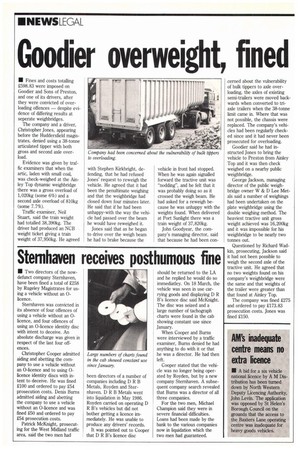Goodier overweight, fined
Page 22

If you've noticed an error in this article please click here to report it so we can fix it.
• Fines and costs totalling £598.83 were imposed on Goodier and Sons of Preston, and one of its drivers, after they were convicted of overloading offences — despite evidence of differing results at seperate weighbridges.
The company and a driver, Christopher Jones, appearing before the Huddersfield magistrates, denied using a 38-tonne articulated tipper with both gross and second axle overload.
Evidence was given by traffic examiners that when the artic, laden with small coal, was check-weighed at the Ainley Top dynamic weighbridge there was a gross overload of 1,020kg (some 6%) and a second axle overload of 810kg (some 7.7%).
Traffic examiner, Neil Stuart, said the train weight had totalled 38,390kg. The driver had produced an NCB weight ticket giving a train weight of 37,950kg. He agreed with Stephen Kirkbright, defending, that he had refused Jones' request to reweigh the vehicle. He agreed that it had been the penultimate weighing and that the weighbridge had closed down four minutes later. He said that if he had been unhappywith the way the vehicle had passed over the beam he would have reweighed it.
Jones said that as he began to drive over the weigh beam he had to brake because the vehicle in front had stopped. When he was again signalled forward the tractive unit was "nodding", and he felt that it was probably doing so as it crossed the weigh beam. He had asked for a reweigh because he was unhappy with the weights found. When delivered at Port Sunlight there was a train weight of 37,820kg.
John Goodyear, the company's managing director, said that because he had been con cerned about the vulnerability of bulk tippers to axle overloading, the axles of existing semi-trailers were moved backwards when converted to triaxle trailers when the 38-tonne limit came in. Where that was not possible, the chassis were replaced. The company's vehicles had been regularly checked since and it had never been prosecuted for overloading.
Goodier said he had instructed Jones to bring the vehicle to Preston from Ainley Top and it was then check weighed on a nearby public weighbridge.
George Jackson, managing director of the public weighbridge owner W & D Lee Metals said a number of weighings had been undertaken on the plate weighbridge using the double weighing method. The heaviest tractive unit gross weight achieved was 16,200kg and it was impossible for his weighbridge to be nearly two tonnes out.
Questioned by Richard Wadkin, prosecuting, Jackson said it had not been possible to weigh the second axle of the tractive unit. He agreed that no two weights found on his company's weighbridge were the same and that weights of the trailer were greater than that found at Ainley Top.
The company was fined £275 and ordered to pay 2173.83 prosecution costs. Jones was fined 2150.








































































































